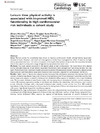Identificador persistente para citar o vincular este elemento:
https://accedacris.ulpgc.es/jspui/handle/10553/73254
| Título: | Leisure time physical activity is associated with improved HDL functionality in high cardiovascular risk individuals: a cohort study | Autores/as: | Hernáez, Álvaro Soria-Florido, Maria Trinidad Castañer, Olga Pintó, Xavier Estruch, Ramón Salas-Salvadó, Jordi Corella, Dolores Alonso-Gómez, Ángel Martínez-González, Miguel Ángel Schröder, Helmut Ros, Emilio Serra Majem, Luis Fiol, Miquel Lapetra, José Gomez-Gracia, Enrique Fitó, Montserrat Lassale, Camille |
Clasificación UNESCO: | 320501 Cardiología | Palabras clave: | Biomarkers Hdl Function Lifestyle Physical Activity |
Fecha de publicación: | 2021 | Publicación seriada: | European Journal of Preventive Cardiology | Resumen: | Physical activity has consistently been shown to improve cardiovascular health and high-density lipoprotein-cholesterol levels. However, only small and heterogeneous studies have investigated the effect of exercise on high-density lipoprotein functions. Our aim is to evaluate, in the largest observational study to date, the association between leisure time physical activity and a range of high-density lipoprotein functional traits. Methods: The study sample consisted of 296 Spanish adults at high cardiovascular risk. Usual leisure time physical activity and eight measures of high-density lipoprotein functionality were averaged over two measurements, one year apart. Multivariable linear regression models were used to explore the association between leisure time physical activity (exposure) and each high-density lipoprotein functional trait (outcome), adjusted for cardiovascular risk factors. Results: Higher levels of leisure time physical activity were positively and linearly associated with average levels over one year of plasma high-density lipoprotein-cholesterol and apolipoprotein A-I, paraoxonase-1 antioxidant activity, high-density lipoprotein capacity to esterify cholesterol and cholesterol efflux capacity in individuals free of type 2 diabetes only. The increased cholesterol esterification index with increasing leisure time physical activity reached a plateau at around 300 metabolic equivalents.min/day. In individuals with diabetes, the relationship with cholesteryl ester transfer protein followed a U-shape, with a decreased cholesteryl ester transfer protein activity from 0 to 300 metabolic equivalents.min/day, but increasing from there onwards. Increasing levels of leisure time physical activity were associated with poorer high-density lipoprotein vasodilatory capacity. Conclusions: In a high cardiovascular risk population, leisure time physical activity was associated not only with greater circulating levels of high-density lipoprotein-cholesterol, but also with better markers of high-density lipoprotein functionality, namely cholesterol efflux capacity, the capacity of high-density lipoprotein to esterify cholesterol and paraoxonase-1 antioxidant activity in individuals free of diabetes and lower cholesteryl ester transfer protein activity in individuals with type 2 diabetes. | URI: | https://accedacris.ulpgc.es/handle/10553/73254 | ISSN: | 2047-4873 | DOI: | 10.1177/2047487320925625 | Fuente: | European Journal of Preventive Cardiology [ISSN 2047-4873], v. 28(12), p. 1392–140, (Noviembre 2021)1 |
| Colección: | Artículos |
Citas SCOPUSTM
12
actualizado el 08-jun-2025
Citas de WEB OF SCIENCETM
Citations
9
actualizado el 08-jun-2025
Visitas
121
actualizado el 28-dic-2024
Descargas
457
actualizado el 28-dic-2024
Google ScholarTM
Verifica
Altmetric
Comparte
Exporta metadatos
Los elementos en ULPGC accedaCRIS están protegidos por derechos de autor con todos los derechos reservados, a menos que se indique lo contrario.
